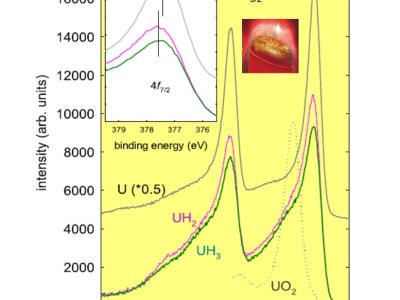
Comparison of 4f photoelectron spectra of U metal and its hydrides reveals the effect of electron-electron correlations, responsible also for the ferromagnetism of both hydrides.
A new review paper dealing with interaction of actinides with hydrogen and physical properties of actinide hydrides has been published in a high-impact journal Reports on Progress in Physics. Interaction of actinide metals with hydrogen is important for energy or military applications, as small amounts of H can lead to breaking of “devices”. The affinity to hydride formation has also its practical side. Uranium metal is used for storing and releasing tritium at nuclear fusion devices. Our interest is mainly understanding of hydrides of actinide metals and intermetallic compounds as solid-state systems combining the lightest and heaviest elements of Periodic Table. The review covering historical development of the field since 1940’s but including latest own research results brings a framework understanding of changes of electronic structure, lattice, and spectroscopic properties due to embedding H atoms to lattice interstitials, yielding a volume expansion and charge transfer between parent metal and H atoms. It brings answers to questions as why the U and Pu hydrides become ferromagnetic. A special section is devoted to high temperature superconductivity of polyhydrides.
Due to generosity of publisher, IoP, the review, resulting from collaboration of the Department of Condensed matter Physics, Faculty of Mathematics and Physics, with Institute of Physics of the Academy of Science, and VSB University of Technology, Ostrava, is available for reading even without subscription (but only for several days) at https://doi.org/10.1088/1361-6633/acbe50.
Full picture note: Comparison of 4f photoelectron spectra of U metal and its hydrides reveals the effect of electron-electron correlations, responsible also for the ferromagnetism of both hydrides. The effect manifests in the change of the shape on the high binding-energy side. The spectra were obtained without exposing to atmosphere on very pure thin films prepared by sputter deposition of U metal in Ar containing H. Experiment performed at JRC Karlsruhe. The research supported by the Czech Science Foundation under the grant 21-09766S.




